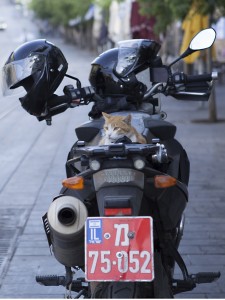A shelter for homeless cats serves as one of the key settings in my current work-in-progress, Halfway to Nowhere. Seeking inspiration for my cat characters, I am always on the lookout for a good cat story. (Translation: A good cat story is any cat story.)
Last week, I saw a segment on Good Morning, America about a suburban Detroit police department’s plan to acquire a police cat. We have police dogs and police horses. Why not police cats?
So many reasons. And I say this as a cat lover.
Yet it turns out that Troy, Michigan, will not be the first police department to hire a cat.
Feline Officers in America
Illinois: Mister Meanor
In 2001, the Lindenhurst Police Department adopted a cat that officers named Mister Meanor. (Who says police officers don’t have a sense of humor?) This kitty apparently had a knack for police and community work. “He yells at [bad guys] the whole way down the hallway, giving them the ‘what for’ with a scolding meow,” Officer Rebecca Labb said. “However, if people here need comforting, he jumps up in their lap and comforts them.”
Update: Gina Warda, Community Service Officer at the Lindenhurst Police Department, kindly responded to my e-mail request for an update on Mister Meanor. “We had to say goodbye to Mister Meanor a few years ago.” She adds, “He was an amazing cat! He would greet visitors, pose for photos, delight children.”
RIP, Mister Meanor! From the photos Officer Ward shared, it’s clear you had a fulfilling life as Police Cat.
Massachusetts: SWAT Cat
In Boston, a stray cat stole the hearts of officers when she showed up outside SWAT headquarters in 2013. Named SWAT Cat after her position as feline mascot of the Special Weapons and Tactics unit, the calico cat handled crucial law enforcement duties, such as getting belly rubs and sleeping on officers’ motorcycles. In 2017, SWAT Cat entered a well-deserved retirement, taking possession of her new, fully-insulated Kitty Condo.
Have there been other Kitty Cops in America? Let me know!
Feline Officers Abroad
Canada: C.C.
For more than 14 years, a cat named C.C. helped keep staff at the Victoria Police Department in British Columbia grounded and calm. “Being a 911 centre, we’re often dealing with life and death emergencies or people who are really negative towards us,” said Anna Mickey, a VicPD communications center operator. “But C.C. will show up on your desk, and when she looks at you, it just brings you right back down to reality.”
An officer found C.C. during a storm in 1999. Officers intended to take the kitten to the SPCA the next day, but she stole everyone’s hearts—except perhaps the police dogs she sometimes tangled with—and became part of the department family.
England: Chief Mouser Tizer
Perhaps they were thinking of T. S. Eliot’s poem “Skimbleshanks: the Railway Cat” when police at a north London railway station recruited a 13-year-old cat to help control their rodent problem. They adopted Tizer from a local shelter in 2007, made him an honorary constable, and gave him the official title of Chief Mouser. Tizer shared an office with Inspector Sloane, one of his human colleagues. Sloane said, “Everyone is always asking after him, and he is probably the most popular member of staff.” He added, “[Tizer] helps other officers ‘de-stress’ and has given a boost to the force’s morale.”
Japan: Officer Lemon
In 2012, a stray cat living on the streets of Kyoto became the first police cat in Japan. Lemon even has his own uniform. Besides keeping employees at the police station happy, Lemon travels with human police officers when they investigate low-risk situations to help calm the crime victims.
Australia: Troop Cat Ed
This feline officer keeps mice on their toes in Australia. The New South Wales Mounted Police had a terrible problem with rodents overrunning the stables. An officer who rescued a stray early in 2016 wondered if the cat might be the perfect pest control solution. Now Ed keeps the stables free of mice—except when he’s napping, as the video at the end of this article reveals.
South Korea: Molang and Her Kittens
Most of the stories I found involve a single cat. But the Gang-seo police station in Pusan, South Korea, claims to have the world’s first police cat family. Early in 2016, officers responding to an accident also found a box of dead kittens. The mother cat observed from afar as they took the kittens away. A few months later, she showed up at the station where those officers worked. She was pregnant again and this time safely delivered her kittens under the watchful eye of the officers. They named her Molang, which means “don’t know,” since they knew nothing about her. Soon, both she and her kittens became unofficial mascots at the Gang-seo station. Human officers take care of their feline colleagues, and Molang keeps them company.
Although it seems that Police Cats, unlike Police Dogs and Police Horses, do not apprehend bad guys or help control crowds, their contributions as community liaisons and morale officers provide invaluable service to their human colleagues.
Back to Troy
Which brings me back to Troy, Michigan, and its search for a community outreach cat. After a grueling “audition” process, the Troy police department chose its first Police Cat on April 6 from among six candidates. The new recruit, weighing only about one pound, will not assume his duties until he reaches the hefty weight of 2 pounds. In the meantime, Troy students will submit possible names, and the police department will ask its Twitter followers to vote for their favorite.
In addition to his work as community ambassador, the new recruit will spend time posting on the department’s Facebook and Twitter pages and help promote pet adoptions from local shelters.
And don’t worry about the five “runners-up.” They are all available for adoption at the Michigan Humane Society’s Westland shelter.
I wouldn’t be surprised to discover stories of many other police cats. I just stopped searching! If you have a police cat in your community or have read stories about other police cats, I’d love to read them.
Despite learning about the many contributions of these impressive feline civil servants, I have no plans to add a Police Cat to Halfway to Nowhere!




